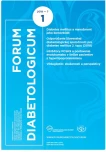PCSK9 inhibitors and the role of evolocumab in the therapy for patients with hyperlipoproteinemia
Authors:
Andrej Dukát 1; Milan Kriška 2; P. Sabaka 3; P. Gavornik 4; M. Kužma 1; Juraj Payer 1
Authors‘ workplace:
V. interná klinika LF UK a UNB, Nemocnica Ružinov, Bratislava
1; Ústav farmakológie a klinickej farmakológie LF UK v Bratislave
2; Klinika infektológie a geografickej medicíny LF UK, SZU a UNB, Nemocnica akad. L. Dérera, Bratislava
3; Angiologická sekcia SLK, Bratislava
4
Published in:
Forum Diab 2018; 7(1): 71-75
Category:
Overview
Relationship between LDL-cholesterol levels and cardiovascular risk is clear nowadays in the evidence-based medicine. Similarly also in the place of statins as the first line therapy among high cardiovascular risk patients. Despite significant improvements in the dyslipidemia therapy for the secondary prevention with statins, this mode of therapy has still certain limitations. Limitations of hypolipidemic treatment have at present two sorts of problems: first is patient and second is the therapy. Therefore new possibilities for significant influence on LDL-cholesterol levels are in research. Nowadays the important place represents the biologic treatment with PCSK-9 inhibitors.
Key words:
atherothrombosis, dyslipidemias, LDL-cholesterol, PCSK9 inhibitors, therapy
Received:
13. 12. 2017
Accepted:
25. 1. 2018
Sources
1. Yusuf S (ed) et al. Evidence based Cardiology. 3rd ed. BMJ Book 2003. ISBN: 978–1405159258.
2. Jellinger PS, Handelsman Y, Rosenblit PD et al. ACCE 2017 Guidelines. American Association of Clinical Endocrinologists And American College of Endocrinology Guidelines for Management of Dyslipidemia and Prevention of Cardiovascular Disease. Endocr Pract 2017; 23(Suppl 2): 1–87. Dostupné z WWW: <https://www.aace.com/files/lipid-guidelines.pdf>.
3. Koenig W. Treating residual cardiovascular risk: will lipoprotein-associated phospholipase A2 inhibition live up to its promise? J Am Coll Cardiol 2008; 51(17): 1642–1644. Dostupné z DOI: <http://dx.doi.org/10.1016/j.jacc.2008.02.025>.
4. Dukát A. Reziduálne kardiovaskulárne riziko – závažný problém, ktorý si bude vyžadovať nové liečebné prístupy. Cardiol Letters 2008; 17(6): 229–233.
5. Mokáň M, Mokáň M, Galajda P. Problémy manažmentu pacienta s diabetom mellitom a viacerými závažnými komorbiditami. Int Med 2014; 14(4): 165–169.
6. Stroes ES, Thompson PD, Corsini A et al. Statin associated Muscle Symptoms: Impact on Statin Therapy-European Atherosclerosis Society Consensus Panel Statement on Assessment, Aetiology and Management. Eur Heart J 2015; 36(17): 1012–1022. Dostupné z DOI: <http://dx.doi.org/10.1093/eurheartj/ehv043>.
7. Murín J, Wawruch M, Mikla F et al. Ako zistiť, že diabetik 2.typu je aj kardiovaskulárne chorý? Diab Obezit 2017; 17(34): 11–15.
8. Vrablík M, Češka R. Novinky v oblasti hypolipidemické léčby. Vnitř Lék 2014; 60(11): 949–957.
9. Vrablík M. Monoklonální protilátky proti PCSK9 v léčbě dyslipidemií. Kardiol Rev Int Med 2014; 16(6): 485–488.
10. Catapano AL, Papadopoulos N. The safety of therapeutic monoclonal antibodies implica-tions for cardiovascular disease and targeting the PCSK9 pathway. Atherosclerosis 2013; 228(1): 18–28. Dostupné z DOI: <http://dx.doi.org/10.1016/j.atherosclerosis.2013.01.044>.
11. Češka R. Studie FOURIER: Přinesla málo, nebo moc? Nebo jen nenaplnila přehnaná oče-káváni? Forum Diab 2017 : 6(3): 109–114.
12. Raal D. What do the OSLER and ODYSSEY data really show? Expert analysis. ACC 2015 Meeting Report. San Diego 15 March 2015.
13. Koren M, Rosenson R, Khan B et al. LDL cholesterol reduction in elderly patients with the PCSK9 monoclonal antibody evolocumab (AMG145): a pooled analysis of 1779 patients in phase 2,3 and open label extension studies. ACC 2015 Scientific Sessions, San Diego 14–16 March 2015. Abstract 1107–101.
14. Holman RR, Koren MJ, Roth E et al. Evaluation of the Glycemic Effects and Efficacy and Safety of Evolocumab (AMG 145) in Subjects With or Without Dysglycemia or Metabolic Syndrome. 285-OR. 75th American Diabetes Association scientific session. Boston. June 2015.
15. Cariou B, Si-Tayeb K, Le May C. Role of PCSK9 beyond liver involvement. Curr Opin Lipidol 2015; 26(3): 155–161. Dostupné z DOI: <http://dx.doi.org/10.1097/MOL.0000000000000180>.
16. Sattar N, Ginsberg H, Ray K et al. The use of statins in people at risk of developing diabe-tes mellitus: Evidence and guidance for clinical practice. Atherosclerosis Suppl 2014; 15(1): 1–15. Dostupné z DOI: <http://dx.doi.org/10.1016/j.atherosclerosissup.2014.04.001>.
17. Fábryová Ľ. Farmakologický manažment diabetickej dyslipidémie. Forum Diabetol 2017 : 6(3): 155–163.
18. Wassef H, Bissonnette S, Saint-Pierre N et al. The apoB-to-PCSK9 ratio: A new index for metabolic risk in humans. J Clin Lipidol 2015; 9(5): 664–675. Dostupné z WWW: http://www.sciencedirect.com/science/article/pii/S1933287415002949. Dostupné z DOI: <http://dx.doi.org/10.1016/j.jacl.2015.06.012>.
19. Lanzieri M. Global Cardiovascular Crisis. J Am Coll Cardiol 2014; 64(21): 2300–2301. Dostupné z DOI: 10.1016/j.jacc.2014.09.027>.
20. Dukát A, Kriška M. Nový prístup v liečbe hyperlipoproteinémií pomocou monoklonálnych protilátok proti proproteínkonvertáze subtilyzín kexín 9 (PCSK9). Int Med 2015 : 15(10): 441–443.
Labels
Diabetology Endocrinology Internal medicineArticle was published in
Forum Diabetologicum

2018 Issue 1
Most read in this issue
- PCSK9 inhibitors and the role of evolocumab in the therapy for patients with hyperlipoproteinemia
- Vildagliptin: experience and prospects
- A consensual therapeutic recommendation for type 2 diabetes mellitus by the Slovak Diabetes Society (2018)
- Comprehensive approach in the management of patients with diabesity
